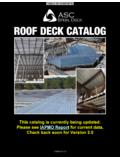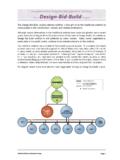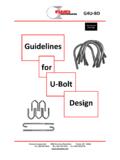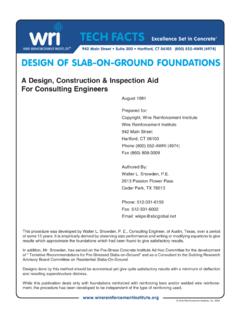Transcription of Design-Build vs. Traditional Construction: Risk and ...
1 Design-Build vs. Traditional construction : Risk and Benefit Analysis I. Project Delivery Method Options and Answers A. The Traditional Approach: design /Bid/ build In the Traditional project, an owner selects an architect or engineer to design plans and specifications. See Figure 1, below. The design professionals analyze the owner's needs and develop design concepts. They then prepare design development drawings, and then construction drawings. Once the design has been fully completed and the construction drawings finished and reviewed by the owner, the project is advertised for bids.
2 Contractors pick up the bid solicitation materials and review a full set of plans and specifications to prepare a bid proposal. If the contractor's price is acceptable, the owner will sign a contract with the contractor and construction can then begin. B. When Fast Track construction Works Best In contrast, with fast track construction , the contractor is selected early in the process -- long before the plans and specifications are complete, and sometimes before the design has even begun. The contractor assists with design development and submits a price proposal before the drawings are complete.
3 Usually, the contractor provides a guaranteed maximum cost, including the contractor's fee, and perhaps some contingencies and allowances. construction starts well before the construction drawings are finished. The designers focus first on the site work, and foundation. While the contractor is moving dirt, and constructing the foundation, the designers prepare drawings for the rest of the project. Some of the design may even be design build (more on that later). As PAGE 1. construction progresses, the designers struggle to keep ahead of the contractor.
4 If all goes well, the fast tracked project will complete in much less time than the Traditional project. The principal advantage of fast track construction is time. The project starts well before the completion of the design and may even finish shortly after the last drawing is released. If all goes well, a project that is fast tracked may complete before the construction contract is even signed on a Traditional project. For those projects where time is real money, fast tracking is an option. If a manufacturing plant is needed yesterday, and construction has not yet begun, fast tracking may be viable.
5 In the 1970's when inflation was out of control, fast tracking helped to avoid some of the price increases. Fast tracking also allows the contractor an early opportunity to provide design input and value engineering. The relationship between the parties should be less confrontational since the contractor is usually not bound to a fixed lump sum price. However, fast tracking is not cheap and has considerable risks. New drawings arrive about every day. There may be coordination problems between drawings, or with existing construction .
6 The contractor is not always able to construct exactly what is shown on the drawings due to field or existing conditions. When the contractor makes changes, the changes need to be immediately communicated to and coordinated with the designer. C. The Inherent Challenges in Multiple Primes Well into the 1800's, the primary approach to construction was the master builder who not only designed the project, but also constructed it. For most of this century, however, construction projects have been managed jointly by the triumvirate of the owner, designer, and general contractor.
7 PAGE 2. Under this approach, the contractor and designer typically exercised day to day control, although the owner has at least nominal control, thanks to the power of its purse. (Remember the Golden Rule: He who has the gold makes the rules.) This Traditional approach involved a single prime contractor who contracted directly with the owner. The general contractor then signed subcontracts with key trade contractors (electrical, mechanical, plumbing, etc.), and acted as the site manager during construction . See Figure 1.
8 The general contractor answered for the quality, cost, and timeliness of the work. The general contractor also assumed responsibility for site safety. The designer traditionally observed the construction to verify general conformance with the plans and specifications and the other contract documents. The designer also visited the site to determine the percentage of completion and to assess the propriety of the contractor's applications for payment. In a multiple prime arrangement, the owner hires various prime contractors (usually, the trade contractors, electrical, mechanical, plumbing, etc.)
9 To perform and control the different portions of the work. There is no general contractor. Each prime contractor is independently responsible to the owner for the cost, timeliness, and quality of the work under its respective contract. The owner acts as its own general contractor or hires a construction manager to control the project. See Figure 2. Under this approach, the various prime contracts must clearly define responsibilities for construction , supervision of the work, site safety, and contract administration, since accountability for the whole of the work is now fragmented among several entities.
10 If the owner is not a sophisticated and effective manager, retaining multiple primes is an accident waiting to happen. Coordination problems are bound to arise if the work of each trade contractor is not scheduled appropriately. If the trade contractors mobilize only to discover that the PAGE 3. project has not progressed sufficiently to accommodate them, or that another trade has had to disturb their work to do their own, there may be significant delay and disruption claims, and massive litigation. For example, in Maintenance Corp.





